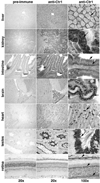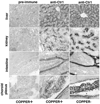Copper transport protein (Ctr1) levels in mice are tissue specific and dependent on copper status
- PMID: 16365053
- PMCID: PMC2718570
- DOI: 10.1093/jn/136.1.21
Copper transport protein (Ctr1) levels in mice are tissue specific and dependent on copper status
Abstract
Studies were conducted to determine distribution of the copper transporter, Ctr1, a transmembrane protein responsible for cellular copper uptake, in adult mice and in suckling mice nursed by either copper-adequate (Cu+) or copper-deficient (Cu-) dams. Western immunoblot analyses, using immunopurified antibody, detected monomeric (23 kDa) and oligomeric forms of Ctr1 in the membrane fraction of several mouse organs. Immunohistochemical analyses detected abundant Ctr1 protein in liver canaliculi; kidney cortex tubules; small intestinal enterocytes; the choroid plexus and capillaries of brain; intercalated disks of heart; mature spermatozoa; epithelium of mammary ducts; and the pigment epithelium, outer limiting membrane, and outer plexiform layer of the retina. Duodenal Ctr1 distribution was different in the adult compared with suckling mice; adult mice demonstrated strong intracellular staining of the enterocyte, whereas apical staining predominated in suckling mice. In Cu- mice at postnatal d 16 (P16), Ctr1 staining was augmented in kidney, duodenum, and choroid plexus, compared with Cu+ mice. Brain immunoblot data indicated that Ctr1 protein in membrane fractions of Cu- mice was 56% higher than Cu+ mice. Cu- mice had lower hemoglobin (56% of Cu+), and lower copper concentration (% of Cu+) in liver (15%), brain (26%), and kidney (65%). These results suggest that Ctr1 protein is expressed in multiple tissues and found in higher levels in selected organs after perinatal copper deficiency. Enhanced Ctr1 levels and redistribution might compensate in part for the decrease in copper supply. Mechanisms for the enhancement in Ctr1 staining remain to be established.
Figures





Similar articles
-
Relative contribution of CTR1 and DMT1 in copper transport by the blood-CSF barrier: implication in manganese-induced neurotoxicity.Toxicol Appl Pharmacol. 2012 May 1;260(3):285-93. doi: 10.1016/j.taap.2012.03.006. Epub 2012 Mar 18. Toxicol Appl Pharmacol. 2012. PMID: 22465424 Free PMC article.
-
Functional and molecular responses of suckling rat pups and human intestinal Caco-2 cells to copper treatment.J Nutr Biochem. 2004 Mar;15(3):155-62. doi: 10.1016/j.jnutbio.2003.10.008. J Nutr Biochem. 2004. PMID: 15023397
-
How copper traverses cellular membranes through the mammalian copper transporter 1, Ctr1.Ann N Y Acad Sci. 2014 May;1314:32-41. doi: 10.1111/nyas.12371. Epub 2014 Feb 20. Ann N Y Acad Sci. 2014. PMID: 24697869 Free PMC article.
-
The role of Ctr1 and Ctr2 in mammalian copper homeostasis and platinum-based chemotherapy.J Trace Elem Med Biol. 2015;31:178-82. doi: 10.1016/j.jtemb.2014.03.006. Epub 2014 Mar 24. J Trace Elem Med Biol. 2015. PMID: 24703712 Free PMC article. Review.
-
Ctr1 and its role in body copper homeostasis.Int J Biochem Cell Biol. 2003 Mar;35(3):288-91. doi: 10.1016/s1357-2725(02)00134-6. Int J Biochem Cell Biol. 2003. PMID: 12531240 Review.
Cited by
-
Links between copper and cholesterol in Alzheimer's disease.Front Physiol. 2013 May 16;4:111. doi: 10.3389/fphys.2013.00111. eCollection 2013. Front Physiol. 2013. PMID: 23720634 Free PMC article.
-
Role of the human high-affinity copper transporter in copper homeostasis regulation and cisplatin sensitivity in cancer chemotherapy.Cancer Res. 2012 Sep 15;72(18):4616-21. doi: 10.1158/0008-5472.CAN-12-0888. Epub 2012 Sep 7. Cancer Res. 2012. PMID: 22962276 Free PMC article. Review.
-
Impairment of interrelated iron- and copper homeostatic mechanisms in brain contributes to the pathogenesis of neurodegenerative disorders.Front Pharmacol. 2012 Sep 25;3:169. doi: 10.3389/fphar.2012.00169. eCollection 2012. Front Pharmacol. 2012. PMID: 23055972 Free PMC article.
-
Copper deficiency myelopathy.J Neurol. 2010 Jun;257(6):869-81. doi: 10.1007/s00415-010-5511-x. Epub 2010 Mar 16. J Neurol. 2010. PMID: 20232210 Free PMC article. Review.
-
Membrane transporters as mediators of Cisplatin effects and side effects.Scientifica (Cairo). 2012;2012:473829. doi: 10.6064/2012/473829. Epub 2012 Nov 25. Scientifica (Cairo). 2012. PMID: 24278698 Free PMC article. Review.
References
-
- Prohaska JR, Gybina AA. Intracellular copper transport in mammals. J Nutr. 2004;134:1003–1006. - PubMed
-
- Vulpe CD, Packman S. Cellular copper transport. Annu Rev Nutr. 1995;15:293–322. - PubMed
-
- Dancis A, Haile D, Yuan DS, Klausner RD. The Saccharomyces cerevisiae copper transport protein (Ctr1p). Biochemical characterization, regulation by copper, and physiologic role in copper uptake. J Biol Chem. 1994;269:25660–25667. - PubMed
Publication types
MeSH terms
Substances
Grants and funding
LinkOut - more resources
Full Text Sources
Research Materials

